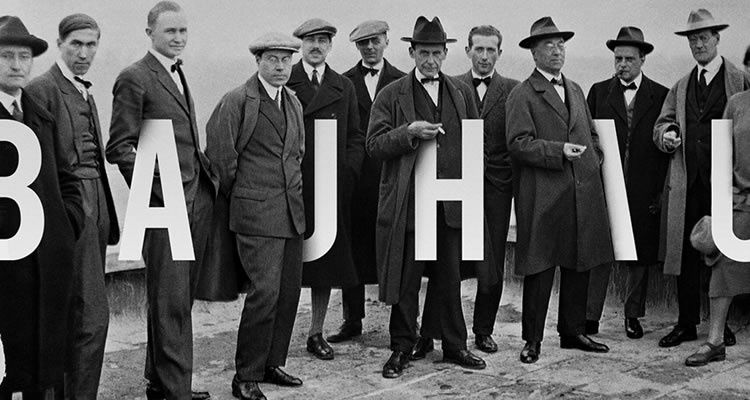Humans have been creating art for thousands of years, with the oldest known human-made works of artistic expression dating back 40,000 years to caves in Indonesia. But despite nearly 40 millennia of humans creating art, the concept of modern art and design education is surprisingly recent.
If you were to be transported back to New York City in 1909, you’d be able to witness the creation of the first United States university with programs in Graphic Design, Advertising, Fashion Design, and more. The school, later named the Parsons School of Design, was created by Frank Parsons, who was one of the first teachers at the New School of Art.

He believed that art and design would soon become deeply connected to the evolution of modern business and industry, and the curriculum he built was focused on teaching students the fundamentals of modern design.
Jump 10 years into the future and take a leap across the Atlantic Ocean to the former Weimar Republic in Germany, and you’d be at the forefront of modern European Design education. Bauhaus was created in 1919 with the intention of bringing all fields of art together and was most influenced by the idea of Modernism.
Modernism was characterized by a focus on simplified forms, rationality, functionality, and the idea that mass production and industry could be reconciled with artistic sensibilities.

These two schools lay the groundwork for the explosion in modern design education. Hundreds, if not thousands, of design and art institutes sprung up throughout the 20th century, making access to modern design education accessible to students around the world.
However, until recent decades, quality design education was available only for students at these institutions. Even if you wanted to teach yourself to be a modern designer, you’d be forced to rely exclusively on textbooks and other written literature, unless you were lucky enough to know a designer who could teach you directly.
And even then, finding work was difficult for anyone without a traditional education or personal connections in the creative industry.
But with the advent of computing, all of that changed. As personal computers became more affordable and the internet sprung to life, access to design education was suddenly available to the masses!
And if you have a computer and stable internet connection today, you can become a designer without a traditional design education, something never before possible.
Here are a few of the best ways to learn the principles of design, hone your skills, and become a working designer without spending $200k on a design education.
Learn the Fundamentals First
Before you download Photoshop or any other design programs, learn the fundamentals! Students in design schools spend 4 years learning the fundamentals of good design. You can learn all the Photoshop techniques in the world but if you don’t understand the concepts underlying modern design, it will be difficult for you to progress beyond a certain level.
Not only will learning the basics help you as you start to work on real projects, but it will also help you figure out what aspects of design you’re most interested in.
- Watch online courses on design fundamentals on Coursera and Skillshare
- Read books about Typography, Design Principles, and the History of Design
- Immerse yourself in popular design sites like Tutsplus, Sitepoint, 52 Weeks of UX, and UXADAY
As you learn about design fundamentals, you might start to naturally gravitate towards certain areas of the field. If you find the fundamentals of fonts and typefaces particularly interesting, you might want to focus your studies on typography.
If you’re particularly drawn to the idea of elegant user experiences and are constantly studying the layout of websites, you might want to focus your future studies on User Experience and User Interface design.

Get the Design Tools You Need and Work on Some Projects
Once you start to understand the basic concepts that underlie modern design, you can start getting familiar with the tools designers use everyday. You don’t need to become an expert, but understanding how tools like Photoshop and Sketch work will make things much easier once you start going through a more structured curriculum.
First, get trials of Adobe and Sketch’s product suite. Here’s a quick primer on the main programs used by designers around the world:
- Photoshop – one of the most powerful image-editing, retouching, and and composition programs in the world and a must have for any aspiring designer
- InDesign – the best tool for creating professional layouts and a godsend when creating multi-page documents or publications
- Illustrator – a vector design tool you’ll need to create digital artwork from scratch
- Sketch – a quickly spreading tool in the design community that makes web and app design simpler than ever before
Next, start playing around with your new tools by working on some projects that excite you.
HOW Design has a great list of some starter projects or you can schedule a quick chat with some of the design mentors on RookieUp, a community of creative professionals who have years of experience helping aspiring designers improve their work and build careers in the design industry.

Decide on an Educational Path
Finally, the most important part of all – figuring out an educational track that works for you. There are practically infinite resources available online to learn design, which means that no matter what your preferred learning style is, there’s a perfect path out there for you.
One note is that, despite most e-learning tools being largely impersonal, studies show that an element of 1-on-1 teaching in your education can significantly improve your ability to improve quickly, so having periodic personalized coaching sessions with real designers is very important as you learn design.
In-person Bootcamps
In recent years, bootcamps have exploded onto the education scene and for good reason. These programs are intensive three month training grounds where you’ll learn directly from real designers and constantly be working on projects with other aspiring creatives like yourself.
These programs are fairly pricey and require you to live in a sizable city, but if you can afford it, they’re a great way to get a condensed design education in a short period of time. And once you complete the course, most bootcamps have career placement teams to help you find junior design jobs! Check out bootcamps like:
- General Assembly is probably the largest global bootcamp company, with campuses around the world
- Shillington is a design education school that has been operating for over 20 years and has campuses in NYC, Europe, and Australia
Digital Bootcamps
Since not everyone lives in a major city, many bootcamps are now digital. These courses let you work from the comfort of your desk and combine live webinar lessons with periodic 1-on-1 mentor sessions throughout the course.
- Springboard is a great online bootcamp with courses in UX Design
- Bloc is mostly focused on coding bootcamps but starting to test out Design bootcamps as well
Check out sites like Course Report to find bootcamps that are perfect for you, both online and in-person!
Self-Learning
Bootcamps aren’t right for everyone. Some people might prefer not to spend $15-20k on a course when they can get a similar education for <$100. Luckily, there are a ton of great (and cheap) online courses for learning design that let you work at your own pace. These options are also ideal for people who don’t want to quit their jobs or move across the country to attend a full-time bootcamp.
- Coursera has a massive number of Design courses that are literally the same courses taught at major universities
- Skillshare and Udemy are two e-learning marketplaces that offer thousands of design courses covering every possible topic
- Treehouse is a fantastic platform that lets you choose a skill and will then guide you through the fundamentals via simple video lessons and interactive projects
- YouTube is perhaps the deepest trove of resources available anywhere, and it’s all free! There are thousands of incredible teachers who produce thousands of videos designed for new designers. Find a designer you like, like Roberto Blake, and follow their videos
Again, 1-on-1 learning is really important when learning design. Periodically chatting with an experienced designer is crucial to reduce frustration, get answers to your questions, receive critique on your work, and ensure you’re on the right path.
Since most self-learning platforms are built without personalization in mind, check out platforms like RookieUp throughout your self-learning journey. RookieUp lets you set up 30 and 60 minute mentor sessions with creative professionals whenever you need to chat with someone who knows what you’re going through.
Alternately, you can attend some design meetups in your city, which are a great way to meet other creatives who might be interested in mentoring you!
I’d recommend chatting with a designer before you get started on a more intense curriculum, when you finish projects and want feedback, and when you’re starting to look for your first job or freelancing gig.
Hopefully after reading this, you’re convinced that a design education is more accessible now than ever before in history. Whereas you used to need to attend a design school to become a designer, you can now learn design and find a job as long as you have a computer and a drive to learn!
So get out there and make your creative dreams a reality.
Related Topics
Top